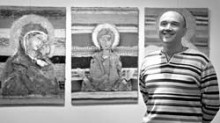Petro Bevza has baffled Kyiv’s artistic circles. Actually, the source of perplexity was his vernissage, which to the uninitiated is somewhat mysteriously called “TsKI, or Images of Slow Happiness,” the ancient Rus’ abbreviation of the word “board.” Icon painters called their works “boards” and executed them on wood covered with a special alabaster-and-chalk priming mixture called levkas.
Of course, it was not so much the title of the show that aroused genuine interest in the master’s new series of paintings as the subject itself and its realization. Bevza is a land-art painter and photographer. The magic of nature in all its manifestations-land and sea, plains and mountains-lies at the heart of his work. “The environment does not need ideas. It already holds them and they only need to be discovered and emphasized,” he has said.
But his new works are about something different. They may be called “sacred art or modern art, depending on how you view them,” said art critic Oleksandr Luchak of St. Petersburg, referring to Bevza’s artistic experiments.
When I received an invitation to attend his exhibition and saw his paintings on the Internet, the first thing that impressed me was the background underneath the images portrayed in the icon. It was meticulously painted, and its structure resembled the rugs that can be found in any rural home in Ukraine. To my amazement, it turned out that he was not painting on cloth but rough canvas rugs woven by his grandmother. When he was asked how he came up with such an original idea, Bevza said: “Like many things in life, everything happened spontaneously, and very pragmatically at that. I spend a lot of time with the collector and producer Bohdan Batrukh. One day he showed me the plan of a church in whose construction he was involved. I criticized him and ended up paying for this: in an original move, Bohdan suggested that I make some new sketches and I agreed. In the typical pattern of sacred art the coating has to be golden because gold symbolizes eternity. I do not aspire to be an icon painter, so I decided to go my own way. Instead of canvas, I used something that literally lies under our feet-small hand-woven rugs, the kind that my grandmother, my wife’s grandmother, and many others made. Eternity is under our feet. Besides the Creator, our ancestors are also connected to it. Perhaps some day people will say that we too created something in this life.”
The vernissage at the Triptych Gallery was a sort of test for Bevza, who decided to test his revolutionary approach to icon painting on his fellow painters, art critics, and gallery-goers. No one had ever seen these works, not even Batrukh, who provided the spark. The church in the village of Lypivka in Makariv raion (Kyiv oblast) has yet to be built. We may see fresco paintings by Bevza there, but even if the church fails to materialize, we will not be worse off because whether someone likes his new project or not, we have discovered an absolutely unusual Bevza.
Tetiana Savchenko, the director of the Triptych Gallery, says: “Bevza surprises our country’s cultural community on a regular basis. I would say that his effect may spill over into Europe. Today he simply astonished me with his absolutely new art. I don’t dare evaluate the project. His works are unexpected, and not just for me. Critics praise, criticize, and argue about his paintings. This is already an achievement. In a sense, Petro is a child of nature. He paints with gusto, and today’s show is an emotional leap in the opposite direction. Perhaps at this stage of life this is what he needed. I may be revealing very intimate details, but I will say anyway that the originality of his projects lies not only in the need to make draft designs for the church. Not so long ago he lost his mother whom he loved dearly and the choice of the unusual texture, instead of canvas, may also be the son’s obeisance to this dearest of individuals. The vernissage has a dedication to specific people the warmth of whose hands will now be preserved in his works: Stepanyda Parkhomenko, Sofia Ivanenko, and Nelli Vanchurina. Petro is an exceptionally talented and questing individual.”
Bevza’s paintings are known both in Ukraine and abroad: Georgia, Lithuania, Poland, Slovakia, Germany, Switzerland, France, Sweden, and US. I think we will be hearing and reading about him many more times in the future. I discovered him several years ago at his solo show called “Theodosiia,” when we didn’t know each other yet. The show featured the painter’s recollections of his trips through the land of the Cimmerians, in southeastern Crimea, which is now known as the Great Feodosiia, meaning “God-given” in Greek. These blessed places have attracted artists throughout the ages. This is also where I was born and to me this is the best place on earth. So I want to know how the unpredictable Bevza saw it for the first time.







